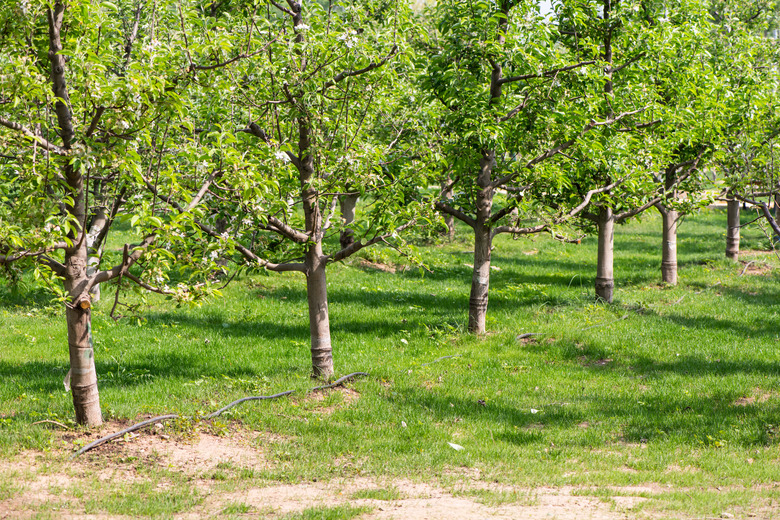How To Calculate Trees Per Acre
We may receive a commission on purchases made from links.
You've just purchased or cleared a nice piece of property, and you want to plant trees — maybe fruit trees, nut trees, or evergreens. Or perhaps you already have an orchard and you need to plan a maintenance schedule for spraying. How can you determine how many trees you can plant or how much pesticide you might need based on an acre of land?
You could always walk around with a tape measure and make copious calculations based on the distance between existing trees or trees you plan to plant. Or you can just walk your acreage and count the trees. An easier option, however, is to use a calculation tool. This works only if the trees you have or plan to plant are the same or similar in size and distance requirements.
A Typical Planting Layout
A Typical Planting Layout
When you plant an orchard, you are generally considering two distances: the distance you want between trees as well as the distance between rows. The distance between rows is usually greater because you'll want space to drive a truck or other vehicle between rows so you can maintain and harvest your orchard.
When you are planting, you'll want to know the spacing you are targeting between your seedlings. If you are instead trying to estimate the number of existing trees on one or more acres, your method of calculation will be different.
Calculating the Number of Trees to Plant
Calculating the Number of Trees to Plant
So you're planting trees! You need to know what trees you will be planting, of course. Trees vary widely in size and hence their required planting spacing. In particular, hardwood and softwood trees are quite different. Hardwood trees always require more space than softwood trees, sometimes double the amount.
For example, if you're planting cherry or apple trees, the recommended spacing is 6 feet to 25 feet between trees depending on whether they are dwarf, semidwarf, or standard size. If instead you are planting landscape trees, consider an elm, which requires a spacing of about 20 feet, or an oak, which requires about 22 feet. The Tree Plantation maintains a list of trees with typical required spacing, but this information is also readily available given an internet search for your type of tree.
Once you know the spacing between the trees, consider how far apart you want to plant the rows. Will you wish to drive a vehicle between rows? If so, you'll need room for the growth of the tree as well as the vehicle. For example, a tree that requires 25 feet of growing space and another 10 feet for a vehicle would need a row about 35 feet wide.
Multiply the row spacing by the tree spacing. For the above example, that would be 35 feet x 25 feet, or 875 square feet per tree. Divide this amount into the number of square feet in an acre, which is 43,560. For this example, the number of trees you should plan to plant is 49.78, or about 50 trees per acre.
Calculating the Number of Existing Trees
Calculating the Number of Existing Trees
If your existing trees are spaced evenly both between the trees and between the rows, your job is a simple calculation and is similar to calculating how many trees to plant. If the spacing varies, you can take advantage of some online tables that can help you determine the number of trees you have. For example, the University of Georgia's Warnell School of Forestry's article "Number of Trees per Acre by Spacing Distance" contains tables with calculations based on a variety of scenarios.
For trees with equal spacing, first measure the number of feet between trees in a row. If it differs just slightly, measure six or more trees and average the spacing. Next, measure the distance between the rows of trees. Average the row spacing if it's inconsistent.
Similar to calculating how many trees to plant, take these two measurements and multiply them so you know the square footage that each tree requires. For example, for trees with 20 feet between them and rows of trees at 25 feet, your calculation is: 20 x 25 = 500 square feet per tree. If your measurements include fractions, use decimals. For example, 15 1/2 feet between rows becomes 15.5.
Divide this total into the square feet in an acre, which is 43,560. Your final calculation is: 43,560/(tree spacing x spacing between rows).
